Page 3 of 5
Re: Machine transparencies (phonographs/parts/etc.)
Posted: Thu Jan 22, 2009 12:53 am
by MordEth
Here’s more Victor advertising, from a scan of an advert in
John’s collection:
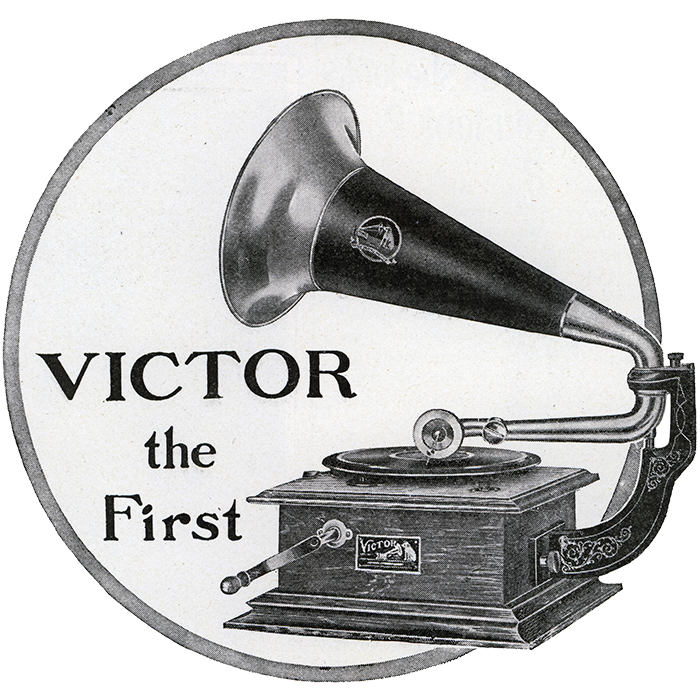
(Click on the image above or this link for a 600 DPI PNG [2520 x 2420 pixels, 12 MB].)
I plan to post a few other variations of this image (with the white circle removed, and just the machine) in following posts.
This image is also available in
avatar format (currently in the ‘machines’ category, although when we have enough images to make it worth doing, I plan on adding a ‘print’ category.
— MordEth
Re: Machine transparencies (phonographs/parts/etc.)
Posted: Thu Jan 22, 2009 3:43 am
by MordEth
Here is the second installment, with the white background inside the circle removed:
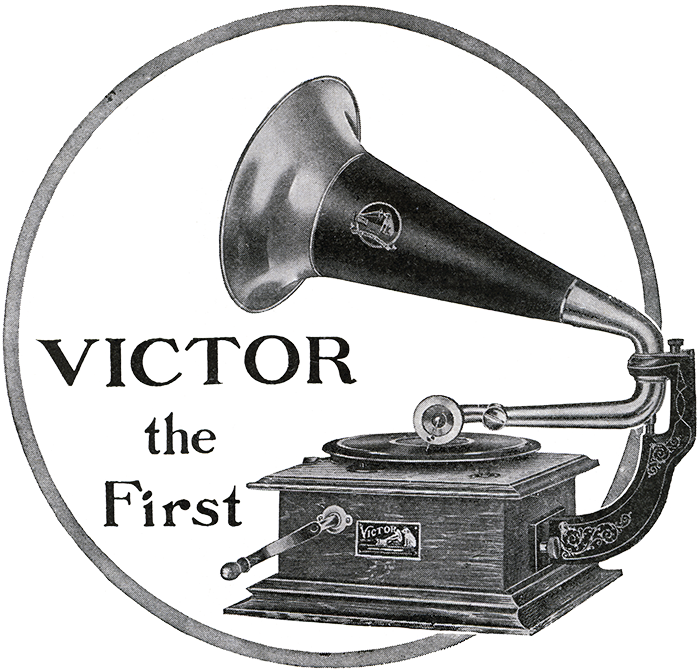
(Click on the image above or this link for a 600 DPI PNG [2520 x 2420 pixels, 6.9 MB].)
There is one more variation forthcoming, and this too is in the
stock avatar gallery.
Enjoy.
— MordEth
Re: Machine transparencies (phonographs/parts/etc.)
Posted: Thu Jan 22, 2009 3:48 am
by MordEth
Here is the third and final installment of tonight’s ‘finally finish cutting out a Victor the First advert’:
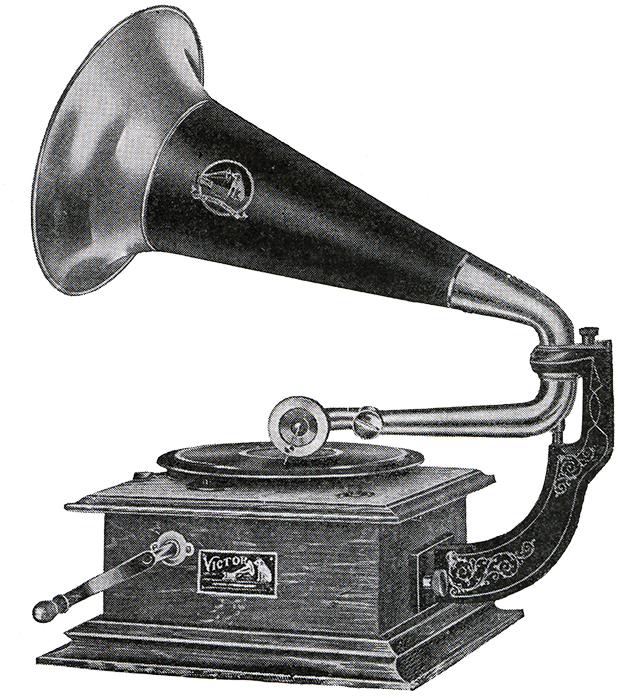
(Click on the image above or this link for a 600 DPI PNG [1809 x 2038 pixels, 5.2 MB].)
There is also in the
stock avatar gallery, and if anyone would like a variation of it (or any of the other black & white images), please let me know. Tinting these sepia or applying ‘technicolor’ to them would not be particularly difficult or time-consuming.
Stay tuned for more!
— MordEth
P.S. If anyone has any Edison print adverts that they would like to scan (particularly at 600
DPI), I would love to get more non-Victor content in here.
Re: Machine transparencies (phonographs/parts/etc.)
Posted: Fri Jan 23, 2009 6:01 pm
by MordEth
From
George P.’s collection, let me present my latest completed cut-out (which is now his avatar):
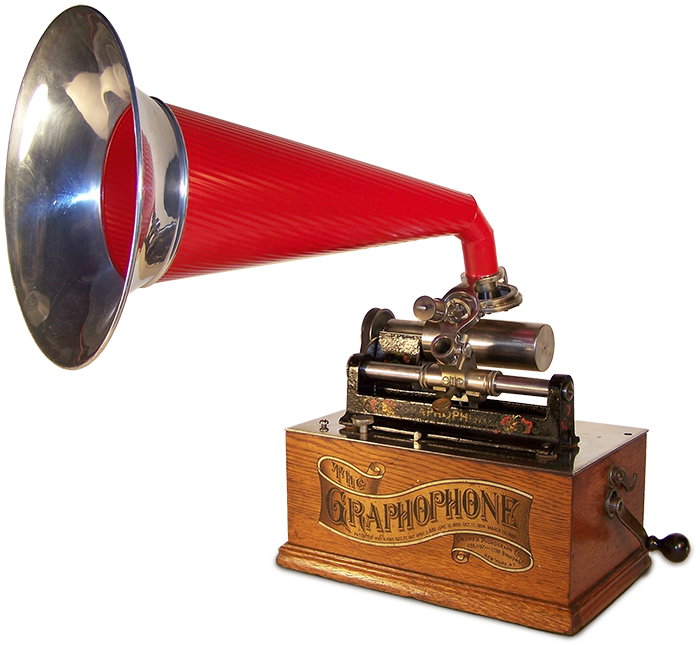
(Click on the image above or this link for the full size PNG [2280 x 2100 pixels, 3.5 MB].)
I’ll let him tell you about it, as obviously he knows far more about this machine (and any other machine for that matter) than I do.

We’re certainly blessed with so many knowledgeable collectors who are willing to share what they know.
— MordEth
Re: Machine transparencies (phonographs/parts/etc.)
Posted: Fri Jan 23, 2009 6:21 pm
by phonogfp
Thanks, David - what a nice job you did!
That's a Type "A" Graphophone from 1897/early 1898. These machines eventually replaced the earlier $40.00 Type "N" and featured the first cast-iron upper works on a Graphophone - - a characteristic that would be seen on many others to follow. Originally selling for $25.00, the Type "A" was a popular model for the Columbia Phonograph Company until phased out in 1899 in deference to the new Type "AT" (also offered for $25.00). Unlike the later "AT," the Type "A" is usually found with a single mainspring, although the motor casting can accommodate two. Type "A" mainsprings did not employ a spring barrel, so as the motor runs, the spring expands against the inner surfaces of the cabinet, sometimes resulting in impressive "chugging."
The earliest Type "A" examples feature a Washington D.C. address on the cabinet decal and a slightly different design on the upper works that collectors refer to as "leaves and berries." This decoration was soon changed to the floral decals found on virtually all subsequent cylinder Graphophones. There are at least four variations of cabinet decals found on the Type "A" - reflecting the rapid expansion of Columbia's sales offices in the U.S. and overseas.
This particular Type "A" is fitted with a Bettini Attachment and No.5 Horn. Bettini equipment delivered arguably the best reproduction of cylinder records in the 1890s. The diaphragms of these models consists of a thin piece of aluminum stretched over the large reproducer body and tightened much like a drum head. The Attachments were available for all Edison Phonographs and most Graphophones, but were relatively expensive. Bettini sold cylinder records as well, for up to $6.00 apiece. As you can imagine, Bettini cylinders are quite rare - even more so than the reproducer/recorder Attachments.
George P.
Re: Machine transparencies (phonographs/parts/etc.)
Posted: Fri Jan 23, 2009 8:14 pm
by MordEth
Hopefully
George won’t mind me quoting a comment that I had made in a private message (and his response) in here, because it might be interesting to other guests and members:
MordEth wrote:I assume that’s a painted metal horn? In the photo, it looks so glossy that it could almost be plastic, but I know that they did not make plastic horns.
George responded:
phonogfp wrote: 
No, it's not plastic!

Someone had used bright red Testor's or some other undesirable paint on this horn, so I had to repaint it the correct shade of Chinese Red. The bell section is aluminum.
From what I can tell (and as you all probably know, I am by no means an expert), he did a very good job with the color and finish on the horn, and certainly a better one than I would have done.
I am only a good painter if I am using a roller to apply paint to a wall.

Getting a good smooth finish with gloss enamel can definitely be an art.
Look forward to seeing (and hopefully hearing about) more machines very soon.
— MordEth
Re: Machine transparencies (phonographs/parts/etc.)
Posted: Sat Jan 24, 2009 4:23 am
by MordEth
Here’s another machine from Steve’s collection that I decided to cut out today.

And in avatar size:
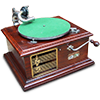
To quote
his information about it:
Napoleon wrote:A 1909 "Pigmy Grand" from The Gramophone Company and the first ever table model of any description from this company, providing customers with both the "Hornless" option and an easily transportable machine to boot!
The follow-up to this machine was a range of "Hornless" gramophones intro'd in 1910 with model No.s 1, 3 & 6. These would be of the more familiar pattern we see today with the plywood horn immediately behind a wooden slatted grille behind a pair of doors. HMV would not venture into the realms of a compact portable machine with integrated carrying case until 1920.
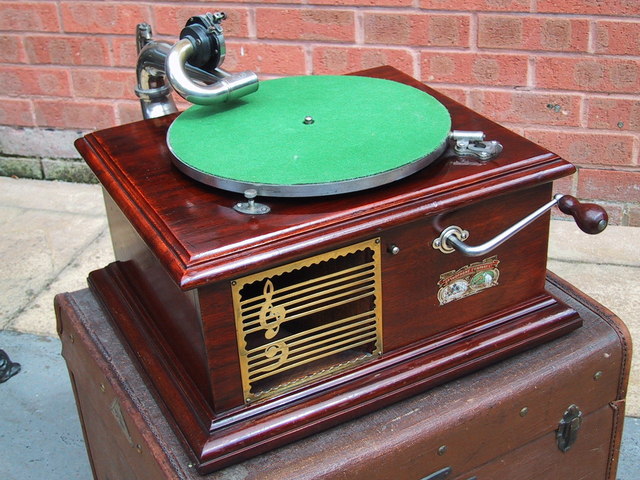
By turning a knurled screw on the back-bracket, the tone-arm is quickly released from the assembly thus making it a compact unit and easily transported in a leather carrying case (sadly this is missing from my collection

)
These were produced in oak, mahogany and satinwood. There was also a double-spring motor variant which is easily identifiable by the serpentine base and overhanging motor board arrangement. To date I have only ever seen 3 double-spring versions and they all appeared on Ebay within weeks of each other (all had some condition issues)!
This single spring example has replacement turntable felt and curiously a G & T Exhibition soundbox (most extant examples have a Gramophone Co. Exhibition s/box). The winder is a modern replacement.
The rest of the machine is untouched and in remarkable original condition.
Re: Machine transparencies (phonographs/parts/etc.)
Posted: Sun Jan 25, 2009 10:34 pm
by MordEth
Here is the Edisonic that 3victrolas has graciously donated to my machines-to-cut-out fund:
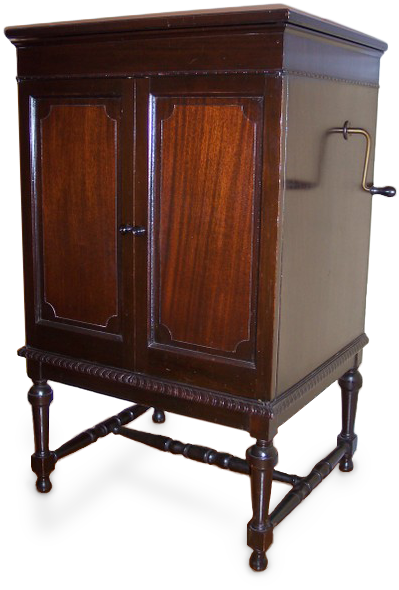
I will let her tell you about it, as she is far more knowledgeable than I am. It can also be found in our slowly expanding ‘machines’ category of the
stock avatar gallery, and I will be adding a transparency of it while open in the (hopefully) not-too-distant future.
Enjoy.
— MordEth
Re: Machine transparencies (phonographs/parts/etc.)
Posted: Sun Jan 25, 2009 11:04 pm
by 3victrolas
This Schubert Edisonic is one of 2 types of Edsonics. The other is the Beethoven. Both were added to the Edison lineup in the fall of 1927 & continued to be produced until Edison got out of the phonograph business in the fall of 1929. The Schubert originally sold for $135 & came w/ a single spring motor. You'll notice that of the various Edison models, the Edisonic models have doors that cover the horn opening. The nice thing about these doors is that they fold back against the cabinet sides. For such a big cabinet, the Schubert really doesn't have much record storage space. You can store 10 next to the platter & another 10 directly underneath. Hope you like the mahognay finish because that was the only one available. Finally, the volume of this machine is quite a bit louder than any of my other Edisons. To fully appreciate this machine you need electric DDs!
Re: Machine transparencies (phonographs/parts/etc.)
Posted: Tue Feb 03, 2009 3:40 am
by MordEth
I’ve meant to get this up for a few days now, but last week’s attempts at rushing to get things done made a very nice segue into feeling sick over the weekend, and generally feeling like a zombie yesterday.
The next image is
JohnM’s avatar, and an interesting image that he sent to me to cut for him.
Here is the original:
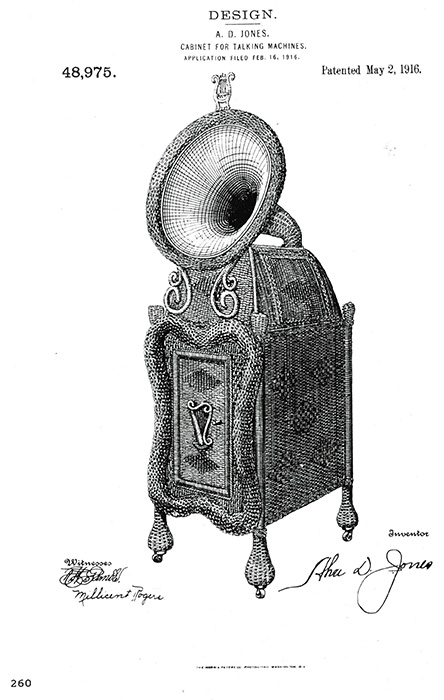
And here is the cut version (although I opted to keep the signature):
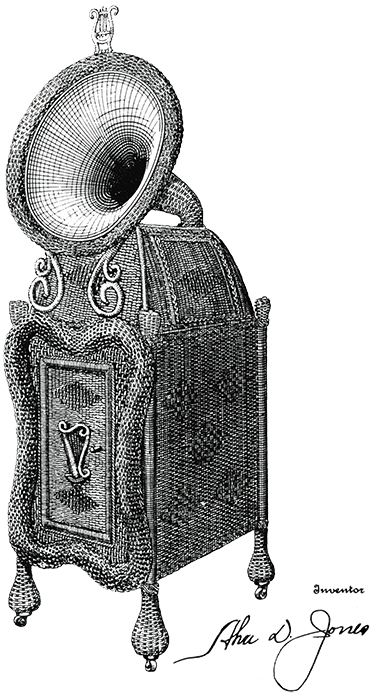
I spent a bit of time attempting to wicker-tone it, but I did not come up with any images that was I tremendously pleased with, particularly at avatar-size on this background color.
Hopefully you enjoy the image—I cannot say that I have seen a wicker phonograph before.
— MordEth








